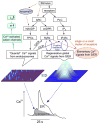TPCs: Endolysosomal channels for Ca2+ mobilization from acidic organelles triggered by NAADP
- PMID: 20159015
- PMCID: PMC2867333
- DOI: 10.1016/j.febslet.2010.02.028
TPCs: Endolysosomal channels for Ca2+ mobilization from acidic organelles triggered by NAADP
Abstract
Two-pore channels (TPCs or TPCNs) are novel members of the large superfamily of voltage-gated cation channels with slightly higher sequence homology to the pore-forming subunits of voltage-gated Ca(2+) and Na(+) channels than most other members. Recent studies demonstrate that TPCs locate to endosomes and lysosomes and form Ca(2+) release channels that respond to activation by the Ca(2+) mobilizing messenger, nicotinic acid adenine dinucleotide phosphate (NAADP). With multiple endolysosomal targeted NAADP receptors now identified, important new insights into the regulation of endolysosomal function in health and disease will therefore be unveiled.
Copyright 2010 Federation of European Biochemical Societies. Published by Elsevier B.V. All rights reserved.
Figures




Similar articles
-
NAADP as an intracellular messenger regulating lysosomal calcium-release channels.Biochem Soc Trans. 2010 Dec;38(6):1424-31. doi: 10.1042/BST0381424. Biochem Soc Trans. 2010. PMID: 21118101
-
Two-pore channels at the intersection of endolysosomal membrane traffic.Biochem Soc Trans. 2015 Jun;43(3):434-41. doi: 10.1042/BST20140303. Biochem Soc Trans. 2015. PMID: 26009187 Free PMC article. Review.
-
Function and dysfunction of two-pore channels.Sci Signal. 2015 Jul 7;8(384):re7. doi: 10.1126/scisignal.aab3314. Sci Signal. 2015. PMID: 26152696 Review.
-
Nicotinic Acid Adenine Dinucleotide Phosphate (NAADP) and Endolysosomal Two-pore Channels Modulate Membrane Excitability and Stimulus-Secretion Coupling in Mouse Pancreatic β Cells.J Biol Chem. 2015 Aug 28;290(35):21376-92. doi: 10.1074/jbc.M115.671248. Epub 2015 Jul 7. J Biol Chem. 2015. PMID: 26152717 Free PMC article.
-
NAADP mobilizes calcium from acidic organelles through two-pore channels.Nature. 2009 May 28;459(7246):596-600. doi: 10.1038/nature08030. Epub 2009 Apr 22. Nature. 2009. PMID: 19387438 Free PMC article.
Cited by
-
Intracellular localization and physiological function of a rice Ca²⁺-permeable channel OsTPC1.Plant Signal Behav. 2012 Nov;7(11):1428-30. doi: 10.4161/psb.22086. Epub 2012 Sep 18. Plant Signal Behav. 2012. PMID: 22990444 Free PMC article.
-
Pathogenic mechanisms of acute pancreatitis.Curr Opin Gastroenterol. 2012 Sep;28(5):507-15. doi: 10.1097/MOG.0b013e3283567f52. Curr Opin Gastroenterol. 2012. PMID: 22885948 Free PMC article. Review.
-
The role of CD38 in Fcγ receptor (FcγR)-mediated phagocytosis in murine macrophages.J Biol Chem. 2012 Apr 27;287(18):14502-14. doi: 10.1074/jbc.M111.329003. Epub 2012 Mar 6. J Biol Chem. 2012. PMID: 22396532 Free PMC article.
-
A New Perspective of Lysosomal Cation Channel-Dependent Homeostasis in Alzheimer's Disease.Mol Neurobiol. 2016 Apr;53(3):1672-1678. doi: 10.1007/s12035-015-9108-3. Epub 2015 Feb 18. Mol Neurobiol. 2016. PMID: 25691454 Review.
-
Crosstalk between intracellular and extracellular salicylic acid signaling events leading to long-distance spread of signals.Plant Cell Rep. 2013 Jul;32(7):1125-38. doi: 10.1007/s00299-013-1451-0. Epub 2013 May 21. Plant Cell Rep. 2013. PMID: 23689257 Review.
References
-
- Yu FH, Yarov-Yarovoy V, Gutman GA, Catterall WA. Overview of molecular relationships in the voltage-gated ion channel superfamily. Pharmacol Rev. 2005;57:387–395. - PubMed
-
- Anderson PA, Greenberg RM. Phylogeny of ion channels: clues to structure and function. Comp Biochem Physiol B Biochem Mol Biol. 2001;129:17–28. - PubMed
-
- Ishibashi K, Suzuki M, Imai M. Molecular cloning of a novel form (two-repeat) protein related to voltage-gated sodium and calcium channels. Biochem Biophys Res Commun. 2000;270:370–376. - PubMed
-
- Furuichi T, Cunningham KW, Muto S. A putative two pore channel AtTPC1 mediates Ca2+ flux in Arabidopsis leaf cells. Plant Cell Physiol. 2001;42:900–905. - PubMed
-
- Calcraft PJ, Ruas M, Pan Z, Cheng X, Arredouani A, Hao X, Tang J, Rietdorf K, Teboul L, Chuang KT, Lin P, Xiao R, Wang C, Zhu Y, Lin Y, Wyatt CN, Parrington J, Ma J, Evans AM, Galione A, Zhu MX. NAADP mobilizes calcium from acidic organelles through two-pore channels. Nature. 2009;459:596–600. - PMC - PubMed
Publication types
MeSH terms
Substances
Grants and funding
LinkOut - more resources
Full Text Sources
Miscellaneous

